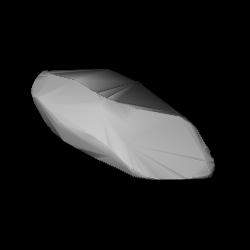4899 Candace, provisional designation 1988 JU, is a background asteroid from the inner regions of the asteroid belt, approximately 7 kilometers in diameter. It was discovered on 9 May 1988, by astronomer couple Carolyn and Eugene Shoemaker at the Palomar Observatory in California, United States. The asteroid was named after American chemist Candace Kohl.

1652 Hergé, provisional designation 1953 PA, is a stony Florian asteroid from the inner regions of the asteroid belt, approximately 9 kilometers in diameter. It was discovered on 9 August 1953, by Belgian astronomer Sylvain Arend at the Royal Observatory of Belgium in Uccle, Belgium. It was later named after Belgian cartoonist Hergé.
3067 Akhmatova, provisional designation 1982 TE2, is a stony Flora asteroid from the inner regions of the asteroid belt, approximately 6 kilometers in diameter.
1717 Arlon, provisional designation 1954 AC, is a binary Florian asteroid from the inner regions of the asteroid belt, approximately 8.5 kilometers in diameter.
2033 Basilea, provisional designation 1973 CA, is a stony asteroid from the inner regions of the asteroid belt, approximately 6 kilometers in diameter. It was discovered on 6 February 1973, by astronomer Paul Wild at the Zimmerwald Observatory near Bern, Switzerland. The asteroid was named for the Swiss city of Basel.
4029 Bridges, provisional designation 1982 KC1, is a stony asteroid and binary system from the middle regions of the asteroid belt, approximately 8 kilometers in diameter.
1736 Floirac, provisional designation 1967 RA, is a stony Florian asteroid from the inner regions of the asteroid belt, approximately 8.7 kilometer in diameter.
1777 Gehrels, also designated 4007 P-L, is a stony asteroid from the middle region of the asteroid belt, approximately 13 kilometers in diameter. It was discovered during the Palomar–Leiden survey in 1960, and named for astronomer Tom Gehrels, one of the survey's principal investigators and credited discoverer.
1722 Goffin, provisional designation 1938 EG, is a stony asteroid from the central region of the asteroid belt, approximately 10.3 kilometers in diameter.

2094 Magnitka (prov. designation: 1971 TC2) is a Flora asteroid from the inner regions of the asteroid belt, approximately 12 kilometers (7.5 miles) in diameter. It was discovered on 12 October 1971, at and by the Crimean Astrophysical Observatory in Nauchnyj, on the Crimean peninsula. The discovery has not been attributed to an observing astronomer. It was later named for the city of Magnitogorsk.
3066 McFadden, provisional designation 1984 EO, is a stony background asteroid from the central regions of the asteroid belt, approximately 15 kilometers in diameter. It was discovered on 1 March 1984, by American astronomer Edward Bowell at the Anderson Mesa Station near Tucson, Arizona. It was named for American planetary scientist Lucy-Ann McFadden. The assumed S-type asteroid has a rotation period of 13.8 hours.
1739 Meyermann, provisional designation 1939 PF, is a stony Florian asteroid from the inner regions of the asteroid belt, approximately 7.5 kilometers in diameter. It was discovered by German astronomer Karl Reinmuth at Heidelberg Observatory on 15 August 1939. It was later named in memory of astronomer Bruno Meyermann.
5080 Oja, provisional designation 1976 EB, is a stony Florian asteroid from the inner regions of the asteroid belt, approximately 8 kilometers in diameter. It was discovered on 2 March 1976, by astronomer Claes-Ingvar Lagerkvist at the Kvistaberg Station of the Uppsala Observatory in Sweden. In 1992, it was named after Estonian–Swedish astronomer Tarmo Oja. The S-type asteroid has a rotation period of 7.222 hours.
1473 Ounas, provisional designation 1938 UT, is a stony asteroid, suspected tumbler and a slow rotator from the middle region of the asteroid belt, approximately 18 kilometers in diameter. It was discovered on 22 October 1938, by Finnish astronomer Yrjö Väisälä at Turku Observatory in Southwest Finland. The asteroid was named after the Finnish Ounas river.
1857 Parchomenko, provisional designation 1971 QS1, is a stony asteroid and suspected binary from the inner regions of the asteroid belt, approximately 8 kilometers in diameter.
1536 Pielinen, provisional designation 1939 SE, is a stony Florian asteroid from the inner regions of the asteroid belt, approximately 7.8 kilometers in diameter. It was discovered on 18 September 1939, by Finnish astronomer Yrjö Väisälä at Turku Observatory, Southwest Finland. It was later named for Finnish lake Pielinen.
1608 Muñoz, provisional designation 1951 RZ, is a Flora asteroid from the inner regions of the asteroid belt, approximately 6.5 kilometers in diameter. It was discovered on 1 September 1951, by Argentine astronomer Miguel Itzigsohn at the La Plata Astronomical Observatory, in La Plata, Argentina. The S-type asteroid has a rotation period of 5.3 hours. It was named after F. A. Muñoz, one of the assistant astronomers at the discovering observatory.
1530 Rantaseppä, provisional designation 1938 SG, is a stony Florian asteroid from the inner regions of the asteroid belt, approximately 5 kilometers in diameter. Discovered by Yrjö Väisälä at Turku Observatory in 1938, it was later named after Finnish astronomer Hilkka Rantaseppä-Helenius.
1573 Väisälä, provisional designation 1949 UA, is a stony Phocaea asteroid, slow rotator and suspected tumbler from the inner regions of the asteroid belt, approximately 9 kilometers in diameter. It was discovered on 27 October 1949, by Belgian astronomer Sylvain Arend at the Royal Observatory of Belgium in Uccle, Belgium. It was named for Finnish astronomer Yrjö Väisälä.
6181 Bobweber, provisional designation 1986 RW, is a stony asteroid from the inner regions of the asteroid belt, approximately 5 kilometers in diameter. It was discovered on 6 September 1986, by American astronomer Eleanor Helin at the U.S. Palomar Observatory in California, and named after astronomer Robert Weber.


